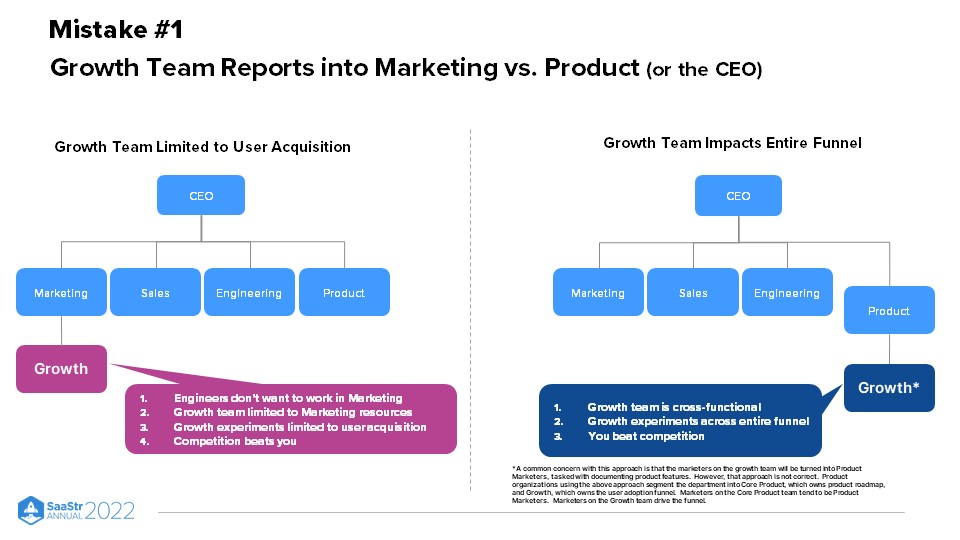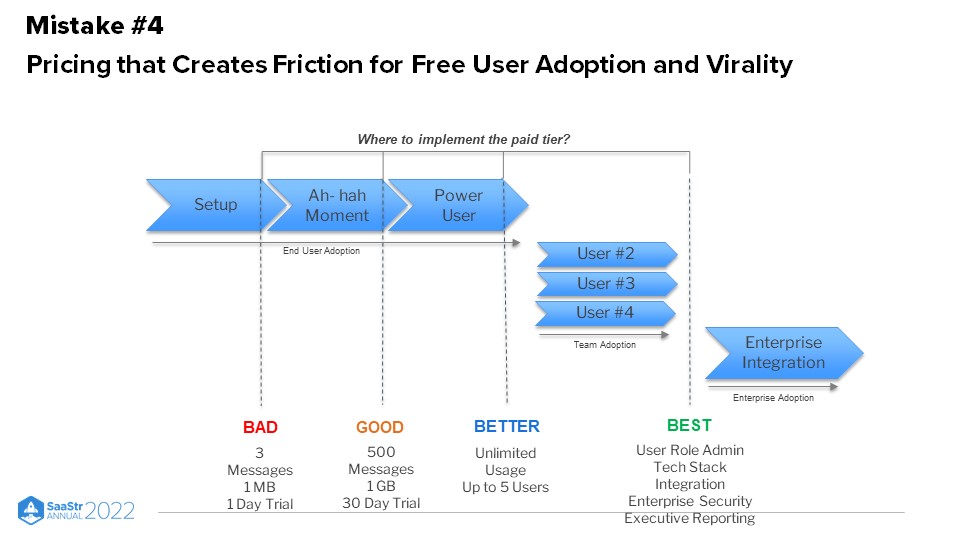Product-led growth (PLG) is the consumerization of software—a strategy B2B software companies can learn from growth teams at successful consumer tech companies.
Stage 2 Capital’s Co-Founder and Managing Director, Mark Roberge, breaks down what a consumer tech growth team looks like and how they operate. He advises bringing these features to a B2B growth team and then shares mistakes that B2B companies make while adding go-to-market (GTM) to PLG.
Breaking down a consumer tech growth team
The growth teams at consumer tech companies such as LinkedIn, Pinterest, and Lyft use the product rather than people to drive users through an adoption funnel. This adoption funnel goes through:
- Free user acquisition
- Free user retention
- Monetization
- Expansion
As consumer tech growth teams move through this adoption funnel, they evolve their north star metric. This evolution can be described in four stages—each stage with a goal measured by a specific metric.

Stage 1: Establish a flow of free users for experimentation. The goal is to get a high number of new free users per day. Paid ads and marketing often achieve this.
Stage 2: Prove free user retention. The goal is to increase the percentage of free users converted to weekly active users. This starts with surveying early users to discover what’s making them stay or leave.
Stage 3: Prove scalable quality user acquisition. It’s time to reduce the customer acquisition cost by experimenting with content marketing and virality. Cost per quality user is the north star metric here.
Stage 4: Prove monetization and expansion. B2B SaaS investors, founders, and growth teams skip ahead to monetization and expansion early and focus disproportionately on them. But this should come at last, where you focus on metrics such as paid user percentage or net dollar retention.

“Consumer growth teams operate to achieve those metrics by high-quality, rapid and data-driven experimentation.”
These experiments are clearly defined and measured throughout the funnel. The data is analyzed through the segmentation of buyer personas. They invest development resources for non-technical people to quickly run and analyze these experiments.
Consumer growth teams are cross-functional. If they aren’t, they get lost in local maximums from a marketing and product perspective, hindering growth. A cross-functional team is aligned with the north star metric to achieve the global maxima and not waste resources and time.

Four mistakes companies make when adding GTM to PLG
As your company grows, there is a requirement to add a sales team with a GTM vision. Founders are worried about ruining the PLG model with a GTM motion. And rightly so—because it often does. Here are four avoidable mistakes made by B2B software companies in adding GTM to PLG.
Mistake #1: Putting your growth team into marketing

Engineers don’t want to work in marketing. When you put your growth team in marketing, it doesn’t attract engineers. The growth team then can experiment on top of the funnel alone, with no experimentation at the product level. As a result, your growth team gets limited to user acquisition.
If you put your growth team in your product team, you’ll create a cross-functional team by attracting engineers. You’ll beat the competition because your experimentation footprint is across the entire funnel. To do it right, divide product teams into two parts, one focused on the core product that owns the roadmap and the other on growth that owns the funnel.
Mistake #2: Scaling sales team disproportionately to growth funnel

A sales team that grows faster than the growth results stresses the salespeople to meet their quota. This leads to salespeople calling users to buy before they have the chance to adopt. Your company accidentally changes from a product-led growth model to a sales-led one.
If you grow the acquisition model faster than the sales team, the PQLs per salesperson increase. Free users adopt the product deeper before the salespeople reach out, and PLG continues.
Mistake #3: Not designing a sales compensation plan for PLG

“We are using the sales compensation models from the 1970s, and these models drive quota-fulfilling behavior.”
In a sales-led compensation plan, the team is rewarded more for the first revenue from a customer and less for the expansion revenue. A first-revenue-focused team stays fixated on offering the paid upgrade for the entire team—even when the team members have not adopted the product.
PLG thrives with expansion-focused sales. In practice, an expansion-focused sales team offers free accounts for team members who haven’t used the product yet. They try to get them to adopt the product before pitching them to buy.
Mistake #4: Pricing that creates friction for free user adoption and virality

Growth teams work hard with product engineering to remove friction from adoption and virality. Pricing by design creates friction.
Pricing after the “aha!” moment but before total adoption is not the best way. It creates friction for the user to transform into a power user. The debate has been whether to price it after the transformation to a power user (before virality) or after the expansion caused by virality. Although it might seem that pushing the pricing as late as enterprise integration (after virality) is leaving money on the table, it’s the smarter call to make.
PLG implementation and failure
Don’t wait to implement PLG till you have some revenue. As your business revenue grows and as you acquire more customers, implementing PLG becomes exponentially more difficult due to cannibalization concerns. The thought that some paying users might shift to the free options you’re providing leads to a lousy implementation of the product-led growth model.
PLG applies to many categories, but not all of them. If you fail after trying to implement PLG, it might not be for you—but you still end up with an easy-to-adopt product. With that, you can easily transition to a sales-led growth model.

